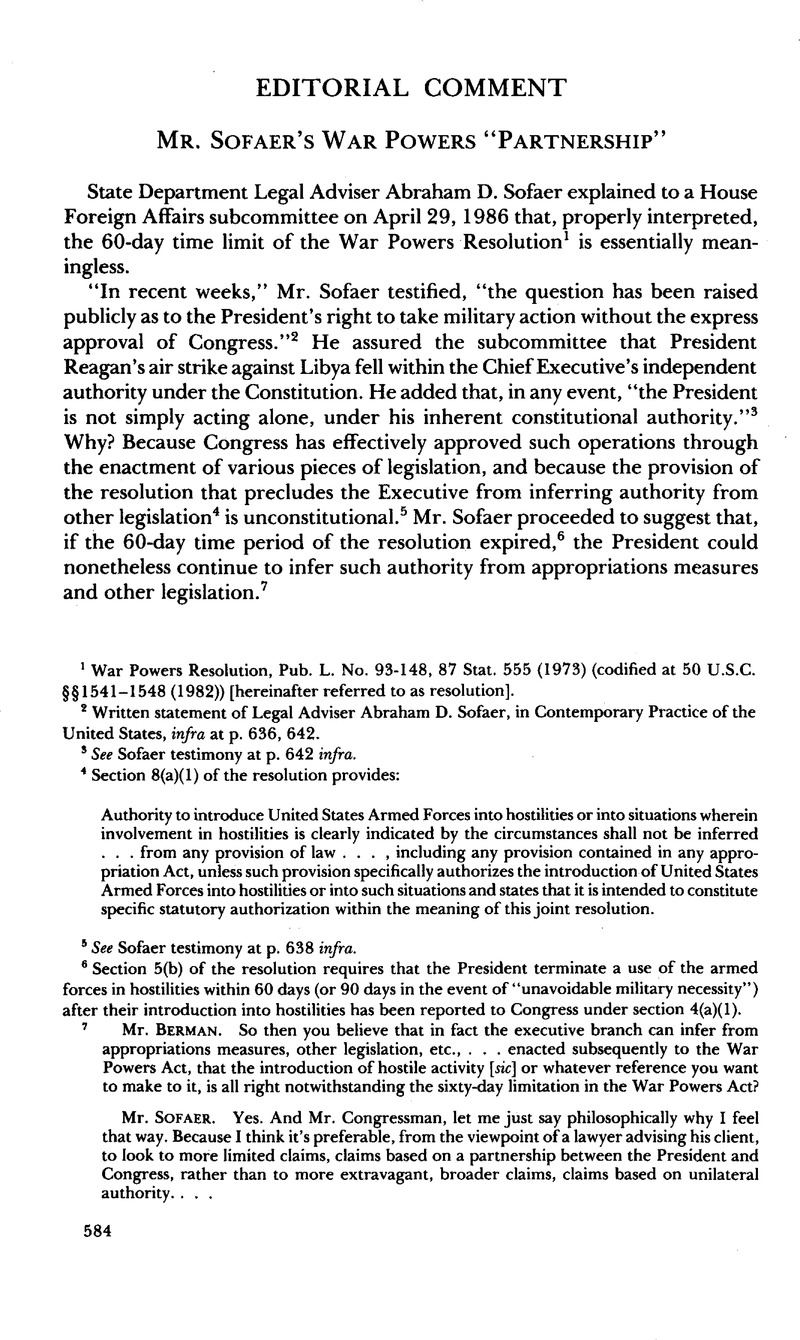Article contents
Mr. Sofaer’s War Powers “Partnership”
Published online by Cambridge University Press: 27 February 2017
Abstract

- Type
- Editorial Comment
- Information
- Copyright
- Copyright © American Society of International Law 1986
References
1 War Powers Resolution, Pub. L. No. 93-148, 87 Stat. 555 (1973) (codified at 50 U.S.C. §§1541–1548 (1982)) [hereinafter referred to as resolution].
2 Written statement of Legal Adviser Abraham D. Sofaer, in Contemporary Practice of the United States, infra at p. 636, 642.
3 See Sofaer testimony at p. 642 infra.
4 Section 8(a)(1) of the resolution provides:
Authority to introduce United States Armed Forces into hostilities or into situations wherein involvement in hostilities is clearly indicated by the circumstances shall not be inferred . . . from any provision of law . . . , including any provision contained in any appropriation Act, unless such provision specifically authorizes the introduction of United States Armed Forces into hostilities or into such situations and states that it is intended to constitute specific statutory authorization within the meaning of this joint resolution.
5 See Sofaer testimony at p. 638 infra.
6 Section 5(b) of the resolution requires that the President terminate a use of the armed forces in hostilities within 60 days (or 90 days in the event of “unavoidable military necessity”) after their introduction into hostilities has been reported to Congress under section 4(a)(1).
7 Mr. Berman. So then you believe that in fact the executive branch can infer from appropriations measures, other legislation, etc enacted subsequently to the War Powers Act, that the introduction of hostile activity [sic] or whatever reference you want to make to it, is all right notwithstanding the sixty-day limitation in the War Powers Act?
Mr. Sofaer. Yes. And Mr. Congressman, let me just say philosophically why I feel that way. Because I think it’s preferable, from the viewpoint of a lawyer advising his client, to look to more limited claims, claims based on a partnership between the President and Congress, rather than to more extravagant, broader claims, claims based on unilateral authority. . . .
I’m naturally drawn, in advising my client, to evidence that Congress will approve of what he’s going to do. . . .
This exchange is taken from a verbatim transcription of a C-Span broadcast.
8 Section 5(b)(1) provides that the President is not required to withdraw the armed forces if Congress “has declared war or has enacted a specific authorization for such use of United States Armed Forces.”
9 This apparently is the first time that the constitutional validity of § 8(a)(1) of the resolution has been challenged by the executive branch.
10 S. Rep. No. 220, 93d Cong., 1st Sess. 20 (1973) (War Powers).
11 See, e.g., §15 of the Act of Aug. 1, 1956, as amended, Pub. L. No. 84–885, 70 Stat. 890 (codified at 22 U.S.C. §2680(a)(1)(b)) (prohibiting appropriations not authorized by law to be made to the Department of State and precluding nonspecific supersession of that prohibition).
- 2
- Cited by




